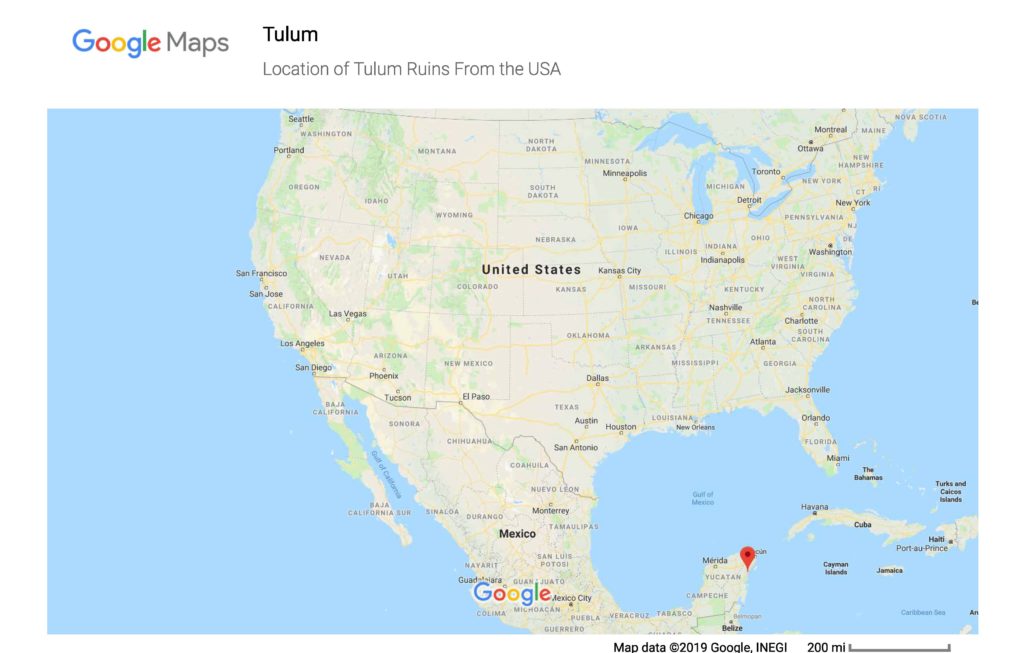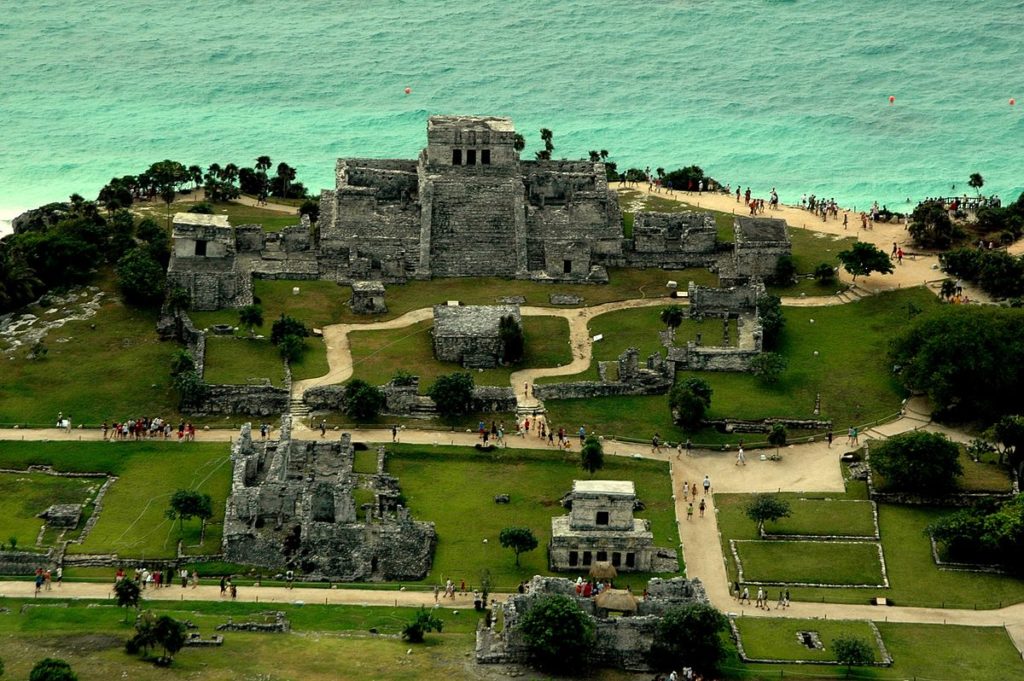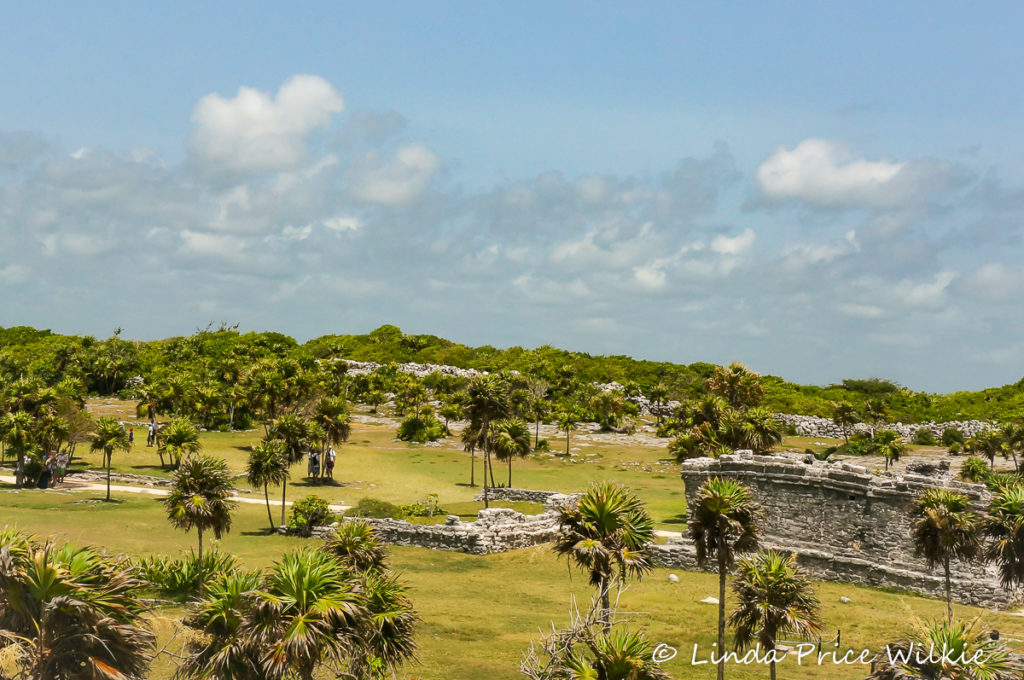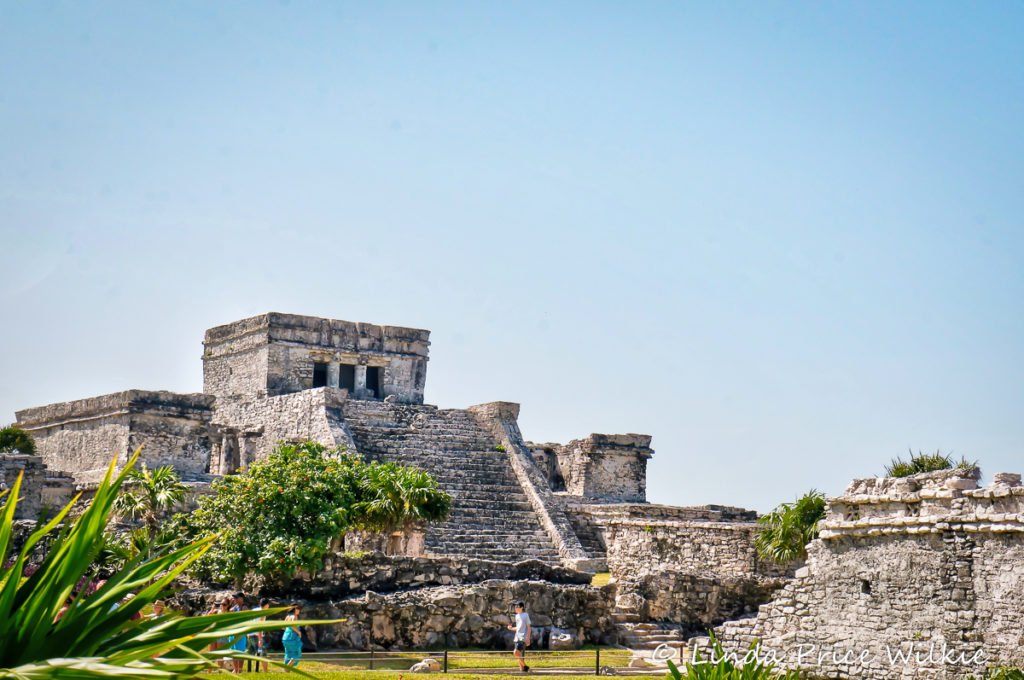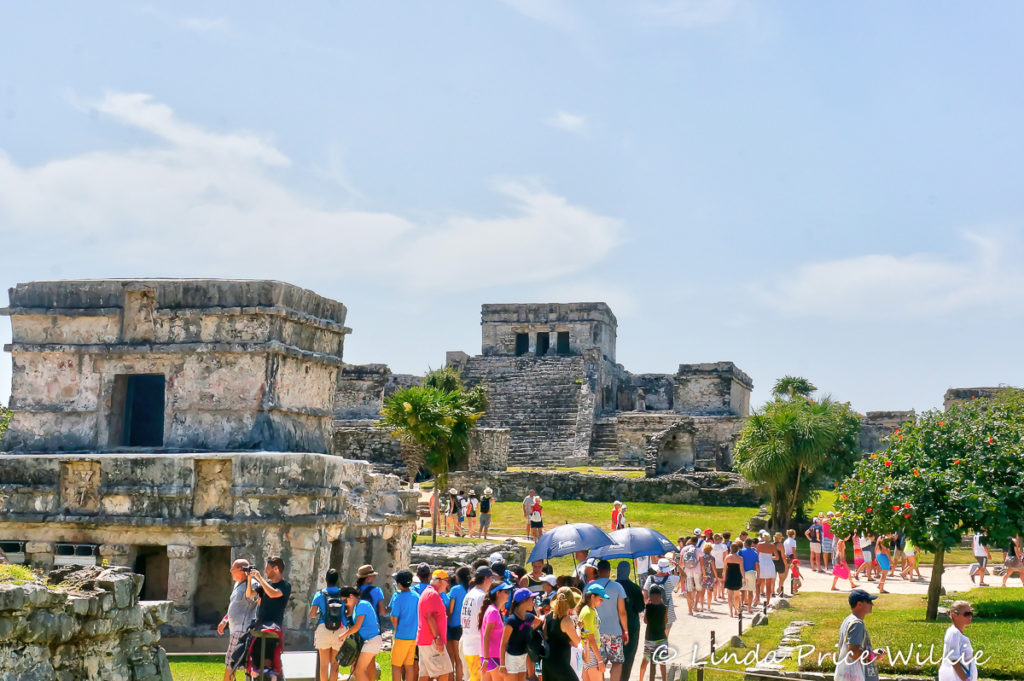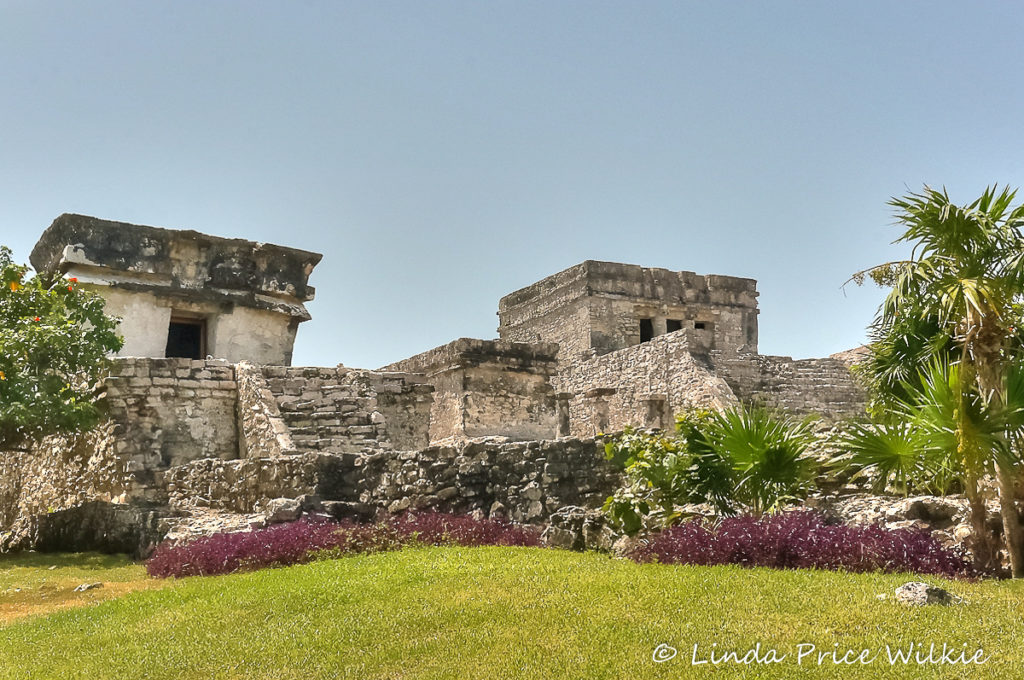You step down off the air-conditioned tour bus, push through the ticket turnstile and pass through a short open doorway in a stone wall into a passageway that opens up to a centuries-old world. “Kiimak ‘oolal”, (“Welcome!”), says your guide in Yucatec Maya. You’ve traveled hundreds of years back in time to Tulum, located on the Yucatán Peninsula of the breathtaking cerulean Caribbean Sea, Quintana Roo, Mexico.
The Wall
Tulum translates to “wall” in Maya and these primitive stone structures are the vestiges of the ancient walled village. Carbon analysis tests confirm the presence of Mayan culture at the ruins as far back as the years 400-600. However, most of the buildings on the site were constructed between the years 1200-1550 when Tulum was an important trade center.
An overview of the Tulum ruins site. Photo Credit: Martha xucunostli
The location of the seaport was well-chosen as Tulum was protected by steep cliffs overlooking the sea on one side, a large thick limestone wall built parallel to the sea side and shorter side walls. The wall paralleling the sea averaged between 9-16 feet high, 26 feet thick and 1,300 feet long. Shorter side walls completing the U-shaped wall design were slightly shorter in height and length.
The Building System
The Mayans used a stacking construction system of a stepped base with buildings set on top. The main structures constructed at Tulum were The Castle, The Temple of the Descending God, The Temple of the Frescoes, and The Temple of the Wind God.

Tulum buildings were erected using a stacking system where buildings were set on tiers of stone bases.
The Castle
Standing 25” tall and the largest of all the buildings on the site, the Castle was erected on a 39’ high cliff overlooking the aqua and azure Caribbean Sea and a white sand beach. It could have been called “The Lighthouse”, due to its function as a beacon to friendly trading ships skirting around the long coral reef along Tulum’s coastline. Without it, the ships could have bottomed out on the jagged coral reef and sunk.
The Mayans devised an ingenious system to bring sea merchants seeking to do business with them safely onto their coast. They sailed out to the sea to meet the incoming vessels and lead them to a line perpendicular to the Castle marking a break in the barrier reef. Then, they turned to face the castle and waited for nightfall. At dark, windows in the Castle were illuminated. The light beams guided the Mayans and their guests to the shore through the break in the reef. They passed through the break to an inlet and a beach safe to shore their boats.
The Temple of the Descending God
A narrow staircase built on a lesser temple base leads to The Temple of the Descending God, which consists of a single room with a door to the west. Above the door is a niche containing a relief sculpture with wings, a headdress and an object in its hand. Historians have yet to offer a consensus opinion as to the meaning of the sculpted figure. It may symbolize the cycle of birth, life, death and afterlife. It may associate with the planet Venus or a god related to Venus who is descending from the sky. Or, it may represent something else entirely.
The Temple of the Frescoes

Mayans used the glyph-decorated Temple of the Frescoes as an observatory for tracking the sun’s movements.
The Temple of the Frescoes is named for the niches in its facade which contain reliefs of Mayan deities. It has a lower gallery and an upper gallery, which the Mayans used in their practice of astronomy. They used the second story as an observatory for tracking the sun’s movements. Some historians believe that the Mayans even conducted a school of astronomy on the the site.
The Temple of the Wind God
Designed as a sanctuary with a small altar, the Temple of the Wind God is located in the northeast corner of Tulum facing the Caribbean Sea. It served the Mayans as a monumental weather vane and an emergency early warning system. Its shape coordinates to the four cardinal points of the compass – north, south, east and west. The Mayans determined the wind direction based upon which corner the wind blew from. They determined wind force with the help of a specially designed hole in the top of the building. When hurricane-force winds blew, the air stream flowing through the hole made a distinctive whistle sound that warned the Mayans to evacuate the area.
Touring Tulum is a must-do historical and cultural excursion when visiting the Yucatán area. It’s an easy day trip add-on to a vacation in the area and is suitable for all active ages (preschoolers may enjoy the outing but not understand the site’s significance).
Good To Know Before You Go:
- The site is open daily from 8 am to 5 pm.
- Here’s a map of the Tulum ruins to view, download to your phone or print and take with you to visit the site
- Bring enough pesos for the entrance fee, plus any purchases you will make from the vendors outside the ruins
- Bring sun protection: hat, sunglasses and suntan lotion
- Wear comfortable walking shoes – there is much to explore!
- Bring a swimsuit – there are steps leading from the ruins down to the beach and the gorgeous, warm Caribbean Sea
- Expect crowds – the ruins are a popular attraction for visitors to the area.
- Allow ample time to walk the grounds, view the historic structures, take photos, splash in the Caribbean and browse the market area.
Sources:
- Ager, Simon. “Useful Phrases in Yucatec Maya.” Omniglot the Online Encyclopedia of Writing Systems & Languages, 2019, www.omniglot.com/language/phrases/yucatec-maya.php.
- “Tulum Arqueological Site Ultimate Guide.” Mayan Peninsula, Sergio Vazquez, 6 Feb. 2019, mayanpeninsula.com/tulum/. This is an excellent resource and beautiful website about Tulum, Chichen Itza, Uxmal and Dzibilchaltun.
- Wikipedia Contributors. “Tulum.” Wikipedia, Wikimedia Foundation, 2 Feb. 2019, en.wikipedia.org/wiki/Tulum.
- Hobe/Holger Behr [Public Domain}. “Tulum.” Wikipedia, Wikimedia Foundation, 2 Feb. 2019, en.wikipedia.org/wiki/Tulum#/media/File:MX_-Tulum.png. (Map of Ruins)
- xucunostli, Martha. “File:Tulum Rising Maya.JPG.” Category:Heidentor (Carnuntum) – Wikimedia Commons, Wikimedia Foundation, Inc., 13 Sept. 2013, commons.wikimedia.org/w/index.php?curid=28392714, 12 Feb. 2019. Photo Credit: Martha xucunostli [CC BY-SA 3.0 (https://creativecommons.org/licenses/by-sa/3.0)]
- “Tulum Ruins.” 7 Feb. 2019, Tulum Ruins – Tulum, www.tulumruins.net/.
- Google Search, Google, www.google.com/maps/place/Tulum,+Quintana+Roo,+Mexico/@33.6668523,-102.8296079,5z/data=!4m5!3m4!1s0x8f4fd40310e42a4b:0xeedc0db93ff9ab7!8m2!3d20.2114185!4d-87.4653502. (Google Map of Tulum Location from USA)
THE TULUM GALLERY
Click on a picture to start the slideshow. Then, click on the “i” in the lower left-hand corner to display the captions.
